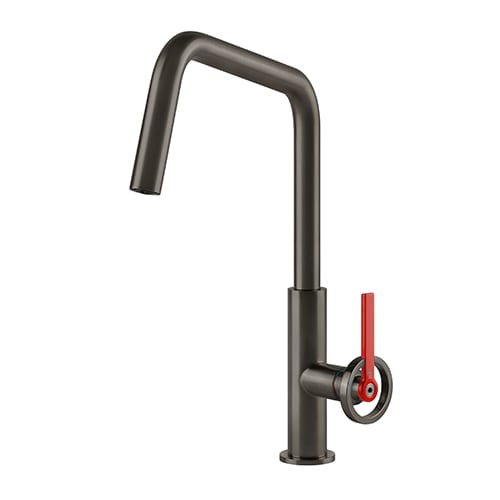Abey’s Custom Metallic Finishes

Abey Australia offers a variety of custom metallic finishes across a range of kitchen and tapware collections. These finishes are created through one of four processes, Galvanic, Painted, Powder Coated & PVD. Within each of these processes, there are then a number of different finishes to choose from, providing a wealth of options for customers looking to find the perfect finish for any beautiful home or living space.
Each finish is developed utilising state of the art technology processes, that allow for exceptional surface quality and a finished product that encases a truly unique design element. Due to Abey’s production process, consistency and availability throughout the warehouses and showrooms are always ensured.
Galvanic Finishes
Abey offers 10 different finishing options through the galvanic finish process. However, there are a few steps that need to be undertaken before a final product can be reached. Firstly, the tapware component is cleaned to remove any grease, dirt or dust. This is done through a few different methods including initially cleaning by hand, then by an automated chain at 80° C and 50°C, followed by a wash with sodium at room temperature. This first step can take between 20 to 25 minutes.
Once the metal piece is washed, a layer of Nickel is applied which acts as a base to the finishes applied later. This layer also offers protection to the tapware through the hardness and thickness of the metal, which is 15 microns thick, as well as reducing any chance of oxidation to the surface. Nickel PWP is used in this step which releases less Nickel than usual, resulting in higher quality tapware that won’t cause any issues to the water supply. Finally, the components are then washed again and sent to the final bath for plating. The plating process gives a hard finish surface, which then has to pass a standard salt spray test to ensure there isn’t any oxidation and to confirm it is up to Abey’s high product standard.

Painted Finishes
As the name suggests, this painted finish revolves around the use of liquid paint on the metal product. However, this isn’t a simple hand-painted job; most of the time a spray, pump or pressurised vessel are used to deliver the wet paint evenly across the product. But before examining this process one important concept to understand is plating; this is the name of the process by which a metal coating (or other treatment) is applied to the surface of a metal part or component. It’s a complicated process, but essentially heat and pressure are then used to fuse the coating and metal component together.
With wet painting, a metal object is first thoroughly cleaned before being blasted with liquid paint to an even thickness of approximately 15-20 micrometres. This process is then continued until there is an even spread across the entire surface and once this has been achieved then plating will occur. The plating not only allows for the final aesthetic look but also adds a layer of protection for the product, making sure it will remain fit for function for years to come. Painted tapware can also produce a much wider range of colours compared to some of the other finish processes and can also produce a much thinner finish which may be extremely valuable based on overall design preferences.

Powder Coated Finishes
Powder coating finish may sound like simply applying powder to a metal object and while this is partially correct, the process itself is a little more complicated. While a dry powder is used, it is applied electrostatically to a cleaned surface to ensure that the dry powder easily attaches. The electrostatic charge is generated through a high voltage electrostatic surge which then causes the powder to become charged and attracted to the metallic surface. Once this layer is then placed on the metal substrate, it is then cured at temperatures as high as 400 degrees for approximately 10 minutes. As the powder melts it then flows around the object and the heat not only melts the powder but also binds the polymer into a heavier polymer that bonds in a tight network-like finish. This creates a dense finish on the metal substrate, which ensures it is much more durable and longer-lasting compared to other options such as conventional painting. Making sure that an individual receives a high-quality finish, along with a high-quality product.

PVD Finishes
PVD or Physical Vapor Deposition is a coating technology that deposits a thin film a few microns in size (for reference one micron is one-thousandth of a millimetre). The process begins inside a vacuum chamber, where solid metals are vaporised. This vapour is then deposited onto the surface of the metal part, atom by atom through condensation. PVD coating itself is one of the most environmentally friendly finishing processes as it produces no chemical waste or water pollution. On top of this PVD is also known for providing strong resistance to abrasions, scratches and corrosion and adds a level of hardness which is highly valued in tapware. Allowing the user to gain exceptional long-life durability, alongside a high-quality aesthetic feature.
Each finishing process offers a wealth of different characteristics and looks to suit a range of styles. Head into one of our selection galleries today to find the perfect metallic finish for your tapware.


